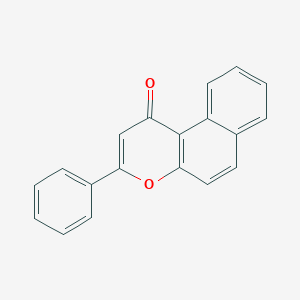Detail Information of Xenobiotics
| General Information of Xenobiotics (ID: XEO01220) | ||||||
|---|---|---|---|---|---|---|
| Xenobiotics Name |
Beta-naphthoflavone
|
|||||
| Xenobiotics Type |
Pharmaceutical Agent(s)
|
|||||
| Classification |
Investigative Agent
|
|||||
| Structure |
<iframe style="width: 300px; height: 300px;" frameborder="0" src="https://embed.molview.org/v1/?mode=balls&cid=2361"></iframe>
|
 |
||||
| 3D MOL | 2D MOL | |||||
| PubChem CID | ||||||
| DME(s) Modulated by This Xenobiotics | ||||||
| DME(s) Inhibited by This Xenobiotics | ||||||
| Aldo-keto reductase 1D1 (AKR1D1) | DME Info | Homo sapiens | [1] | |||
| Aminomuconic semialdehyde dehydrogenase (ALDH12) | DME Info | Homo sapiens | [1] | |||
| Cytochrome P450 1A1 (CYP1A1) | DME Info | Homo sapiens | [2] | |||
| Cytochrome P450 1A2 (CYP1A2) | DME Info | Homo sapiens | [2] | |||
| Cytochrome P450 1B1 (CYP1B1) | DME Info | Homo sapiens | [3], [4] | |||
| Cytochrome P450 2C18 (CYP2C18) | DME Info | Homo sapiens | [5] | |||
| Mephenytoin 4-hydroxylase (CYP2C19) | DME Info | Homo sapiens | [5] | |||
| Cytochrome P450 2C9 (CYP2C9) | DME Info | Homo sapiens | [5] | |||
| Cytochrome P450 2D6 (CYP2D6) | DME Info | Homo sapiens | [6] | |||
| Cytochrome P450 3A4 (CYP3A4) | DME Info | Homo sapiens | [6] | |||
| Cytochrome P450 3A7 (CYP3A7) | DME Info | Homo sapiens | [6] | |||
| Cytochrome P450 4B1 (CYP4B1) | DME Info | Homo sapiens | [6], [5] | |||
| Dimethylaniline oxidase 1 (FMO1) | DME Info | Homo sapiens | [6] | |||
| Glutathione S-transferase alpha-1 (GSTA1) | DME Info | Homo sapiens | [7] | |||
| HMG-CoA reductase (HMGCR) | DME Info | Homo sapiens | [8], [9] | |||
| Keto-steroid reductase (HSD17B7) | DME Info | Homo sapiens | [8] | |||
| Mevalonate pyrophosphate decarboxylase (MPD) | DME Info | Homo sapiens | [9] | |||
| UDP-glucuronosyltransferase 2B10 (UGT2B10) | DME Info | Homo sapiens | [1] | |||
| UDP-glucuronosyltransferase 2B15 (UGT2B15) | DME Info | Homo sapiens | [6] | |||
| DME(s) Induced by This Xenobiotics | ||||||
| Aldo-keto reductase 1A1 (AKR1A1) | DME Info | Homo sapiens | [10] | |||
| Aldo-keto reductase 1C1 (AKR1C1) | DME Info | Homo sapiens | [11] | |||
| Aldo-keto reductase 1C3 (AKR1C3) | DME Info | Homo sapiens | [1] | |||
| Arachidonate 5-lipoxygenase (ALOX5) | DME Info | Homo sapiens | [1] | |||
| Asparagine synthetase (ASNS) | DME Info | Homo sapiens | [12] | |||
| NADPH-dependent carbonyl reductase 1 (CBR1) | DME Info | Homo sapiens | [13], [1] | |||
| Steroid 11-beta-hydroxylase (CYP11B1) | DME Info | Homo sapiens | [14] | |||
| Aromatase (CYP19A1) | DME Info | Homo sapiens | [1] | |||
| Cytochrome P450 2A13 (CYP2A13) | DME Info | Homo sapiens | [6] | |||
| Cytochrome P450 2A6 (CYP2A6) | DME Info | Homo sapiens | [15] | |||
| Cytochrome P450 2B6 (CYP2B6) | DME Info | Homo sapiens | [16], [6] | |||
| Cytochrome P450 2E1 (CYP2E1) | DME Info | Homo sapiens | [17] | |||
| Leukotriene B4 omega-hydroxylase (CYP4F3) | DME Info | Homo sapiens | [18] | |||
| Glutathione S-transferase pi (GSTP1) | DME Info | Homo sapiens | [19] | |||
| Quinone reductase 1 (NQO1) | DME Info | Homo sapiens | [19] | |||
| Sulfotransferase 1E1 (SULT1E1) | DME Info | Homo sapiens | [6] | |||
| Thioredoxin reductase TR1 (TXNRD1) | DME Info | Homo sapiens | [20], [1] | |||
| UDP-glucuronosyltransferase 1A1 (UGT1A1) | DME Info | Homo sapiens | [21] | |||
| UDP-glucuronosyltransferase 1A10 (UGT1A10) | DME Info | Homo sapiens | [15], [18] | |||
| UDP-glucuronosyltransferase 1A3 (UGT1A3) | DME Info | Homo sapiens | [15], [18] | |||
| UDP-glucuronosyltransferase 1A4 (UGT1A4) | DME Info | Homo sapiens | [15] | |||
| UDP-glucuronosyltransferase 1A6 (UGT1A6) | DME Info | Homo sapiens | [18] | |||
| UDP-glucuronosyltransferase 1A7 (UGT1A7) | DME Info | Homo sapiens | [15], [18] | |||
| UDP-glucuronosyltransferase 1A8 (UGT1A8) | DME Info | Homo sapiens | [15], [18] | |||
| UDP-glucuronosyltransferase 1A9 (UGT1A9) | DME Info | Homo sapiens | [22], [15] | |||
| Xenobiotics-DME Activity Data | ||||||
| Xenobiotics-DME Activity Data | Cytochrome P450 1A1 (CYP1A1) | DME Info | IC50 = 0.054 microM | [2] | ||
| Cytochrome P450 1A2 (CYP1A2) | DME Info | IC50 = 0.47 microM | [2] | |||
If you find any error in data or bug in web service, please kindly report it to Dr. Yin and Dr. Li.

